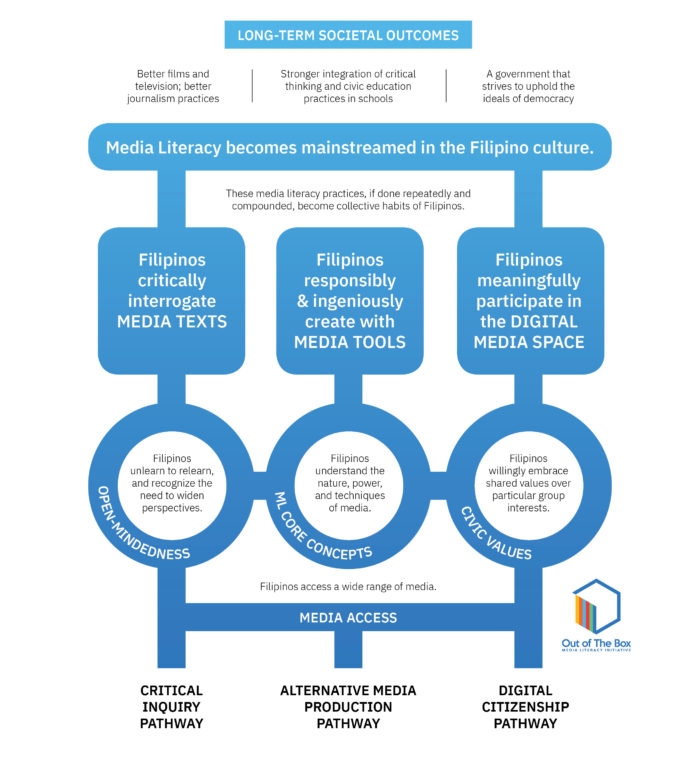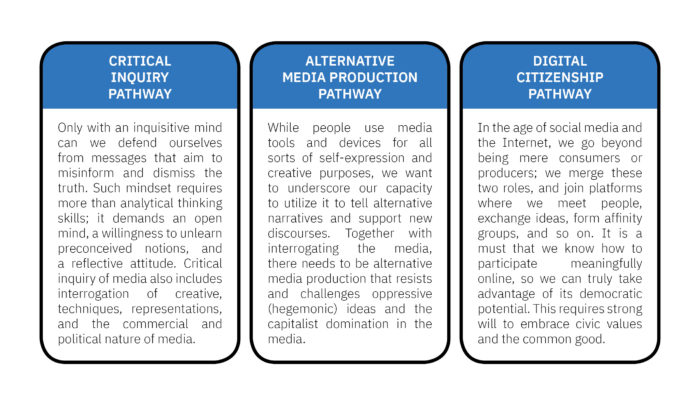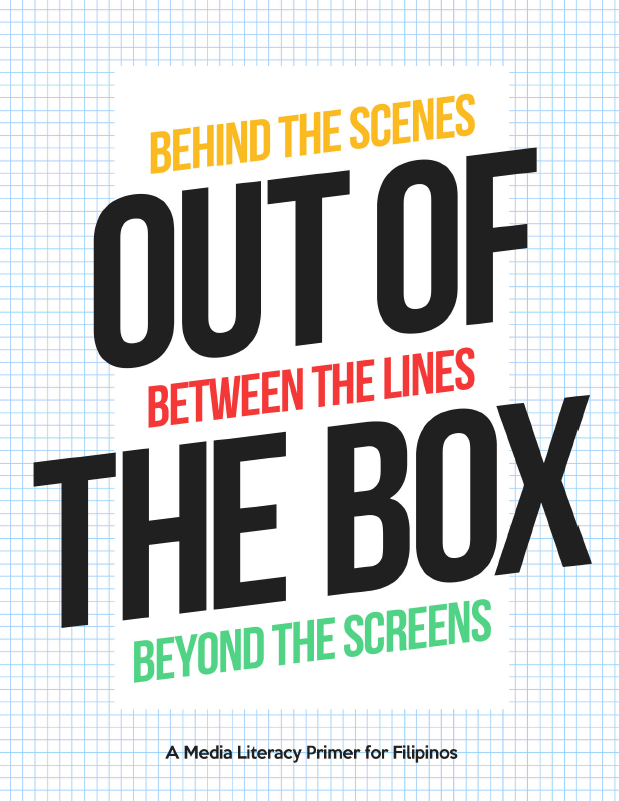
Out of The Box Media Literacy Initiative’s Theory of Change (TOC) offers a framework that defines media literacy as a set of three distinct yet overlapping practices: to interrogate media texts, to create with media tools, and to participate meaningfully in the digital media space. Moreover, this framework maps out our vision of mainstreaming media literacy in the Philippines from addressing media access, to the fundamental prerequisites of the practice of media literacy, to the long-term societal outcomes of media literacy for the Philippine society.
Vision: We envision media literacy practices to be mainstreamed in the Filipino culture. We want Filipinos to always be interrogating and creating media and participating meaningfully in the digital media space. As we cultivate these norms, we actively shape the country to be truly democratic, free and just for all.
Three Media Literacy Pathways: Out of The Box conceives media literacy along three distinct yet overlapping practices (pathways): Critical Inquiry, Alternative Media Production, and Digital Citizenship. Each of these pathways correspond to a particular way of conceptualizing media: as texts (to be interrogated), as tools (for creation), and as a space (where one can participate in civics). These involve a wide range of skills, knowledge, and values that work together in order to actualize holistic practices.
Long-term Societal Outcomes: Once media literacy becomes part of the Filipino culture we envision its impact in the media industry, in education, and in government. These institutions need to respond to more critical and proactive Filipino media consumers and citizens. We hope for better news coverage, better films and TV; stronger integration of critical thinking and civic education practices in schools; and a government that strives to uphold the ideals of democracy.

A. Media Access
Media access is the gateway to media literacy. In understanding access, we recognize the following realities: (1) the pervasive nature of media and (2) the digital divide. First, media seeps through all aspects of our lives, impacting our identities, values, and experiences. Our daily exposure to media, both incidental and intended, makes media literacy important to all individuals across ages, social classes, professions, and so on. While we recognize the omnipresent quality of popular media, there remains a wide disparity in media access and use, especially when it comes to digital media technologies referred to as the digital divide. Both contexts must be considered to best promote media literacy practices in specific settings and to specific segments of the society.
B. Media Literacy Core Concepts
Media have embedded values and ideals that are transmitted and become part of culture.
Mass media are culture industries—channels of communication that produce and distribute TV shows, movies, songs, newspapers and other cultural products that transmit cultural values and ideals. This means that the way we view ourselves, others, and the world is largely influenced by the media that we consume.
Media messages are constructed using a creative language with its own rules.
Media texts are composed of signs and symbols that can be deconstructed to uncover its underlying meanings. In building these texts, media producers adopt creative techniques to attract people’s attention and elicit response. At the same time, media consumers or audiences decode these messages and negotiate their own understanding of the media based on their prior knowledge and experiences.
Media is business.
Most media are created for profit, benefitted by just a few media corporations. With few big players controlling the media market, the media products tend to have limited diversity; they stick with what sells—restricting innovation, choice, and difference. The commercial nature of media directly influences the limitations of mainstream news media coverage, the ills of the Philippine movie industry, and the extractive business model of the Big Tech.
C. Open-Mindedness
One cannot effectively engage in critical inquiry of media without an open mind. A media literate person has to open up to differing opinions and perspectives and has to develop the capacity to unlearn preconceived notions and relearn them through new lenses. Open-mindedness is beyond cognitive skills; it is a person’s attitude towards truth and reality.
D. Civic Values
There are certain virtues that guide people in following democratic principles and procedures that manifest in everyday life. These guide how people identify themselves as citizens, as members of a community, and participate in public life. As citizenship has expanded to digital spaces, it is important for people to commit to the values of democracy to stimulate engagement and generate action.

Our OOTB Media Literacy Primer contains facts about the ownership of Philippine media and Filipinos’ access to them, issues of the local press, and concepts for analyzing media messages, among others. We developed this primer as a guide for teachers, students, and other advocates to further understand the language and power of media and how, as Filipinos, we can take advantage of our media consumption and production. This primer is given during OOTB workshops and events as part of the Media Literacy Kit.
a person who consumes and engages with media messages to derive truthful meaning
creative rendering of a promotion that uses different forms of media
any form of media text that contrasts and counters the popular, mainstream media
medium that transmits information via airwaves for public knowledge
education response that expands the notion of literacy to include different forms of mass communication, popular culture, and new technologies
meaningful exchange of information; conversation between/among individuals
figurative or symbolic meaning of a word aside from its literal meaning
social and economic order that encourages the purchase of goods and services
reception of idea or message from different forms of media
process of breaking media texts to derive critical analysis of hidden messages
literal meaning of a word
concept of developing a person’s skills and knowledge to effectively use the Internet and other digital technology, especially in order to participate responsibly in social and civic activities
ability to use information and communication technologies to find, evaluate, create, and communicate information, requiring both cognitive and technical skills
digitized content that can be transmitted over the Internet
formal and intelligent written or spoken discussion
false information deliberately disseminated to deceive
moving images or pictures
ability to critically read a film’s message through both its technical and narrative aspects
system of beliefs that guides or explains how society works; leads to social action
ability to recognize when information is needed and to research, evaluate, and use effectively the needed information
reportage of accurate and truthful current events for the public’s information
ability to read, write, and comprehend
the public
collective means of communication
inaccurate information disseminated to mislead
reportage of current events
acquisition of critical thinking skills for analyzing and judging the reliability and accuracy of news we consume
person who consumes media messages without much questions
newspaper, magazine, and other media printed on paper
person who consumes media messages without much questions
concept in which objective facts are less influential in shaping public opinion than statements that appeal to emotion
the creation of different forms of media texts
form of broadcast that only transmits sound
ways how the media portray particular peoples, experiences, or topics through lens of a particular ideology
disseminating and perpetuating information that has been consumed and believed
study of meaning-making or interpretation through language and images
category of media where people converse, participate, engage online
widely held but fixed and oversimplified idea of a particular type of person or thing
hidden, underlying message
form of broadcast that transmit moving images projected on screen
any form of media product
Schedule an Appointment
[mc_contact_top form=MakeAnAppointment]